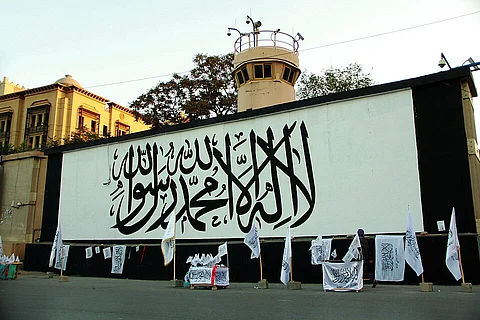

Recently, rumors began circulating online about alleged U.S. military activity at Bagram Air Base in Afghanistan. These rumors culminated last week when reports emerged of a U.S. military aircraft landing at the base, sparking false claims that the Taliban-led government had handed Bagram back over to the U.S.—something President Donald Trump has expressed interest in multiple times since returning to office in January.
Many armchair analysts online believed the story, calling it a geopolitical masterstroke and referring to Bagram as a “crown jewel” for the U.S. But it was all nonsense. Anyone with even a basic understanding of the Taliban and their 20-year struggle against the U.S. would know that such a move is inconceivable. While Bagram Air Base itself isn’t as strategically vital as some may think, Afghanistan as a whole holds considerable importance—especially in the emerging multipolar world.
Recent moves by Russia to remove the Taliban from its list of terrorist organizations, along with diplomatic engagement by neighboring countries, have kept Afghanistan in the headlines—contrary to the belief that the Taliban’s return to power in 2021 marked the end of the Afghan story.
Afghanistan sits at the intersection of West Asia (the Middle East), the Indian Subcontinent, Central Asia, and East Asia. In fact, there’s ongoing debate about whether Afghanistan belongs to the Middle East, Central Asia, or the Indian Subcontinent.
In modern times, it served as a buffer state between the Russian and British Empires. During the Cold War, it stood at the crossroads of the Soviet Union and Western-aligned Pakistan—making it a major focus for both superpowers. Today, Afghanistan lies at the intersection of Chinese, Iranian, Russian, and U.S. spheres of influence.
From 2001 to 2021, the U.S. occupation of Afghanistan allowed Washington a strategic vantage point, preventing other regional powers from linking up through the country without U.S. supervision or approval.
The “grand chessboard” thinkers in the Trump Administration understand this reality. It helps explain recent diplomatic overtures between Washington and Kabul, including the U.S. dropping its bounty on Taliban Deputy Leader and Interior Minister Sirajuddin Haqqani—a figure responsible for numerous suicide bombings during the occupation. The U.S. is seeking to reestablish influence in Kabul to act as a potential spoiler in this increasingly vital region.
The Reality of Today
It’s been less than four years since Afghanistan emerged from 42 years of continuous conflict, civil war, and two foreign occupations. Regardless of opinions about the Taliban, the entire country is now at peace and unified under a single government for the first time since 1973.
The Taliban government understands Afghanistan’s strategic position and has worked to deepen ties with China, Iran, Russia, and Central Asian nations.
Projects initiated under the previous government—such as the TAPI gas pipeline, TAP-500 electricity project, and CASA-1000 hydroelectric initiative—aim to connect Central Asia’s energy grid with Pakistan, using Afghanistan as a vital hub. The country benefits through transit fees and energy access.
While north-south connectivity is important, Afghanistan’s real long-term strategic value lies in its east-west potential.
Why It Matters
Afghanistan lies between Iran and China—two nations central to the multipolar world and both on the U.S. “threat list.” For the first time in modern Afghan history, the Taliban have begun constructing a highway through the mountainous Wakhan Corridor, creating a direct land route to China. This bypasses Central Asia and enables bilateral trade without intermediaries.
The government has also expressed interest in becoming a key trade hub between Iran and China by developing rail links in western Afghanistan.
While its geography places it at the crossroads of Asia, Afghanistan also serves as a potential bypass for China's Belt and Road Initiative (BRI). Pakistan remains under significant U.S. influence, with Washington effectively blocking proposed Iranian gas pipelines into the country. Additionally, Chinese engineers working on BRI projects in Pakistan have faced persistent attacks from Baloch separatists.
The former Soviet republics in Central Asia also remain vulnerable to foreign interference, color revolutions, and Western influence through organizations like USAID. The January 2022 unrest in Kazakhstan was described by Russian President Vladimir Putin as externally orchestrated.
A BRI route through Afghanistan would allow uninterrupted development and connect directly to the North-South Corridor—an alternative trade route being developed by Russia and Iran to link Russia with India while bypassing Western-controlled routes.
When the Taliban marched into Kabul in August 2021, the West aimed to isolate Afghanistan diplomatically and economically, citing moral objections to the Taliban’s social policies. However, the war in Ukraine and the broader shift toward multipolarity in 2022 changed the equation. China quickly established full diplomatic relations with the Taliban government, and Russia followed by turning over the Afghan embassy in Moscow to the new regime.
The Future Looks Bleak, But Hopeful
Afghanistan remains a poor country and will likely face economic challenges for years to come. But its geography and strategic position are unchanging, making it a persistent focal point for major powers.
It is virtually impossible that the Taliban will ever allow Afghanistan to be subordinated to the U.S. again. Instead, they appear determined to chart an independent path forward, developing relations with neighboring countries. Ironically, the same nation many of us grew up viewing as a war-torn battlefield is now a stable lynchpin in the future of global geopolitics.